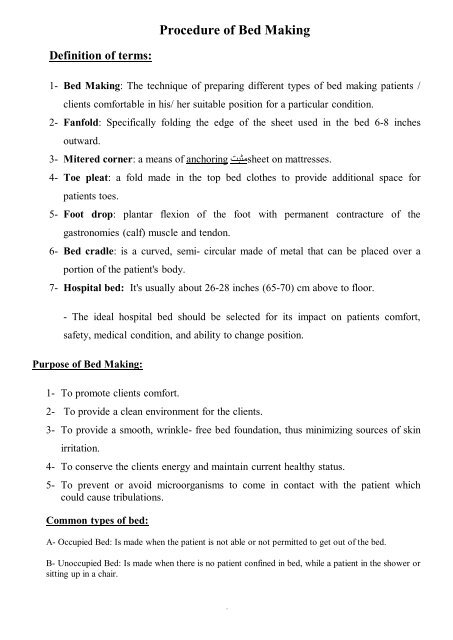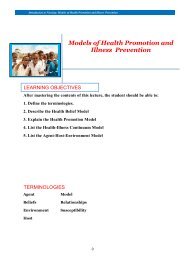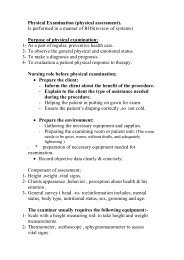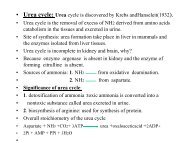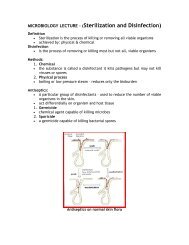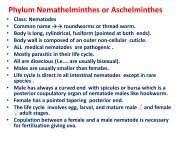Procedure of Bed Making
Procedure of Bed Making
Procedure of Bed Making
- No tags were found...
You also want an ePaper? Increase the reach of your titles
YUMPU automatically turns print PDFs into web optimized ePapers that Google loves.
<strong>Procedure</strong> <strong>of</strong> <strong>Bed</strong> <strong>Making</strong><br />
Definition <strong>of</strong> terms:<br />
1- <strong>Bed</strong> <strong>Making</strong>: The technique <strong>of</strong> preparing different types <strong>of</strong> bed making patients /<br />
clients comfortable in his/ her suitable position for a particular condition.<br />
2- Fanfold: Specifically folding the edge <strong>of</strong> the sheet used in the bed 6-8 inches<br />
outward.<br />
3- Mitered corner: a means <strong>of</strong> anchoring sheetمثبت on mattresses.<br />
4- Toe pleat: a fold made in the top bed clothes to provide additional space for<br />
patients toes.<br />
5- Foot drop: plantar flexion <strong>of</strong> the foot with permanent contracture <strong>of</strong> the<br />
gastronomies (calf) muscle and tendon.<br />
6- <strong>Bed</strong> cradle: is a curved, semi- circular made <strong>of</strong> metal that can be placed over a<br />
portion <strong>of</strong> the patient's body.<br />
7- Hospital bed: It's usually about 26-28 inches (65-70) cm above to floor.<br />
- The ideal hospital bed should be selected for its impact on patients comfort,<br />
safety, medical condition, and ability to change position.<br />
Purpose <strong>of</strong> <strong>Bed</strong> <strong>Making</strong>:<br />
1- To promote clients comfort.<br />
2- To provide a clean environment for the clients.<br />
3- To provide a smooth, wrinkle- free bed foundation, thus minimizing sources <strong>of</strong> skin<br />
irritation.<br />
4- To conserve the clients energy and maintain current healthy status.<br />
5- To prevent or avoid microorganisms to come in contact with the patient which<br />
could cause tribulations.<br />
Common types <strong>of</strong> bed:<br />
A- Occupied <strong>Bed</strong>: Is made when the patient is not able or not permitted to get out <strong>of</strong> the bed.<br />
B- Unoccupied <strong>Bed</strong>: Is made when there is no patient confined in bed, while a patient in the shower or<br />
sitting up in a chair.<br />
1
Types <strong>of</strong> unoccupied <strong>Bed</strong>:<br />
1- Open bed: the top covers are folded back so the patient can easily get back in to<br />
bed.<br />
2- Closed bed: the top sheet blankets and bedspreads are drawn up to the head <strong>of</strong> the<br />
mattress and under the pillow; this is prepared in a hospital room before a new client<br />
is admitted to the room.<br />
3- Post-operative bed: known as recovery bed or anesthetic bed, and used for a<br />
patient with large cast or other circumstance that would make it difficult for him to<br />
transfer easily into bed.<br />
Kinds <strong>of</strong> Linens<br />
A- Blanket: a large piece <strong>of</strong> clothe <strong>of</strong>ten s<strong>of</strong>t, woolen and is used for warmth as a bed<br />
cover.<br />
B- Top sheet: used to cover the patient to provide warmth, made <strong>of</strong> thick cotton,<br />
thermal material.<br />
C- Cotton draw sheet: a piece <strong>of</strong> cloth that the rubber sheet and is used to absorb and<br />
moisture.<br />
D- Bottom sheet: used to cover the bed after mattress cover.<br />
E- Rubber sheet: used to protect the bottom sheet from soothing due to patient<br />
secretions and prevent the patients from getting bedsore. It's usually placed over the<br />
center <strong>of</strong> the bottom sheet.<br />
Guidelines in <strong>Bed</strong> <strong>Making</strong><br />
Rational<br />
1- Wash hand thoroughly before and after handling - helps to control nosocomial infection<br />
clients bed linen<br />
2- Hold soiled linens a way from the body. - To avoid contact with nurses clothes and to<br />
avoid spreading micro-organism.<br />
3- Linen for one client is never placed on another - to avoid transporting micro-organism from<br />
client's bed.<br />
patient to patient<br />
4- Soiled linens is placed directly in a portable linen - To limited the patient secretion and avoid<br />
hamper or tucked in to a pillow case at the end <strong>of</strong> the contamination with other furniture.<br />
2
ed before it is gathered up for disposal in the linen<br />
hamper or in linen chute. Pillowcase is then tied and<br />
labeled with: name, room number, communicable/<br />
non communicable.<br />
5- Soiled linen is never shaken in air. - To avoid spreading microorganism<br />
6- When stripping and making a bed, conserve time - To avoid time and energy waste.<br />
and energy by stripping and making up one side as<br />
completely as possible before working on the other<br />
side<br />
7- Gather all needed linen before starting to strip the - To keep time, energy, and quality <strong>of</strong> work.<br />
bed.<br />
8- Move any furniture away from the bed - To provide ample working space.<br />
Skills in <strong>Bed</strong> <strong>Making</strong>:<br />
- Stripping the <strong>Bed</strong>: Removal <strong>of</strong> used linen and the airing <strong>of</strong> the mattress.<br />
<strong>Procedure</strong>:<br />
1- Place chair at the foot <strong>of</strong> the bed.<br />
2- Locked the bed.<br />
3- Remove pillow case from pillow. Place pillow on chair.<br />
4- Loosen all bed linens starting at center <strong>of</strong> head <strong>of</strong> bed, raising the mattress with one<br />
hand and draw out bed clothes with other.<br />
5- Remove sheet separately. Fold each linen with soiled part inside. Wrap them all in a<br />
sheet and place on lower bar <strong>of</strong> the bed.<br />
6- Roll rubber sheet and place on chair.<br />
7- Remove mattress cover.<br />
1- Unoccupied <strong>Bed</strong>:<br />
A- Closed <strong>Bed</strong>:<br />
Equipments: a- Mattress cover<br />
b- bottom sheet, c- Rubber sheet, d- cotton draw sheet.<br />
e- Top sheet, f- pillow cases (2), g- Blanket, H- <strong>Bed</strong> spread.<br />
3
<strong>Procedure</strong>:<br />
1- Wash your hands thoroughly, done gloves<br />
2- Bring clean linen to patients bedside<br />
3- Move any furniture away from the bed to provide ample working space.<br />
4- Locked the bed.<br />
5- Lower the head <strong>of</strong> the bed to make the mattress level and ensure tight-fitting,<br />
wrinkle- free linens, and then raise the bed to a comfortable working height to<br />
prevent back strain.<br />
6- When stripping the bed, watch for the patient's eye glasses, dentures, or other<br />
belongings that may have fallen among the linens.<br />
7- Remove the pillowcase and place it in the laundry bag or use the pillowcase, hooked<br />
over the back <strong>of</strong> a chair, as a laundry bag. Set the pillow aside.<br />
8- Lift the mattress edge slightly and work around the bed, un tucking the linens. If<br />
you plan to reuse the top linens, fold the top hem <strong>of</strong> the spread down to the bottom<br />
hem. Then pick up the hemmed corners, fold the spread into quarters, and hang it<br />
over the back <strong>of</strong> the chair. Do the same for the top sheet.<br />
9- Remove the soiled bottom linens, and place them in the laundry bag.<br />
10-If the mattress has slid downward, push it to the head <strong>of</strong> the bed; adjusting it after<br />
bed making loosens the linens.<br />
11-Place the bottom sheet with its center fold in the middle <strong>of</strong> the mattress. For a fitted<br />
sheet, secure the top and bottom corner over the mattress corner on the side <strong>of</strong> the bed<br />
nearest you. For a flat sheet, align the end <strong>of</strong> the sheet with the foot <strong>of</strong> the mattress, and<br />
miter the top corner to keep the sheet firmly tucked under the mattress.<br />
12-To miter the corner, the first tuck the top end <strong>of</strong> the sheet evenly under the mattress<br />
at the head <strong>of</strong> the sheet the side edge <strong>of</strong> the sheet a bout 30 cm from the mattress corner<br />
and hold it at a right angle to the mattress. Tuck in the bottom edge <strong>of</strong> the sheet<br />
hanging the mattress. Finally, drop the top edge and tuck it under the mattress.<br />
How to make a mitered corner:<br />
1-Laying a triangular fold <strong>of</strong> 2- Tucking the end <strong>of</strong> the sheet 3- Pulling the triangular fold over the side<br />
Sheet on the bed. Under the mattress the mattress<br />
4
13-After tucking under one side <strong>of</strong> the bottom sheet, place the rubber sheet and then<br />
draw sheet (if needed) about 38 cm from the top <strong>of</strong> the bed, with its center fold in the<br />
middle <strong>of</strong> the bed. Then tuck in the entire edge <strong>of</strong> the draw sheet on the side <strong>of</strong> the bed<br />
nearest you.<br />
14-Place the top sheet with its corner fold in the middle <strong>of</strong> the bed and its wide hem<br />
even with the top <strong>of</strong> the bed. Allow enough sheet at the top <strong>of</strong> the bed to form a cuff<br />
over the spread<br />
15- Place the spread over the top sheet, with its center fold in the middle <strong>of</strong> the bed.<br />
16- Make a 7.6 cm to pleat, or vertical tuck, in the top linens to allow room for the<br />
patient's feet and to prevent pressure that can cause discomfort, skin breakdown,<br />
and foot drop.<br />
17- Tuck the top sheet and spread under the foot <strong>of</strong> the mattress. Then miter the bottom<br />
corners.<br />
18- Move to the opposite side <strong>of</strong> the bed and repeat the procedure.<br />
19- After fitting all corners <strong>of</strong> the bottom sheet or tucking them head the mattress, pull<br />
the sheet at an angle from head toward the foot <strong>of</strong> the bed. This tightens the linens,<br />
making the bottom sheet taut and wrinkle-free and promotion patient comfort.<br />
20- Fold the top sheet over the spread at the head <strong>of</strong> the bed to form a cuff and to give<br />
the bed a finished appearance, when making an open bed, if a linen-saver pad is<br />
needed, place it on top <strong>of</strong> the bottom sheets.<br />
21- Slip the pillow in to a clean case, tucking its corners well into the case to ensure a<br />
smooth fit. Then place the pillow with its seam toward the top <strong>of</strong> the bed to prevent<br />
it from rubbing against the patient's neck, causing irritation, and its open edge<br />
facing away from the door to give the bed a finished appearance.<br />
22- Lower the bed and lock its wheels to ensure patient safety.<br />
23- Return furniture to its proper place, and place the call button within the patients<br />
easy reach. Carry soiled linens from the room is outstretched arms to avoid<br />
contaminating your uniform.<br />
24- After disposing <strong>of</strong> the linens, remove gloves if used and wash your hands<br />
thoroughly to prevent the spread <strong>of</strong> microorganisms.<br />
5
B- Open <strong>Bed</strong>: Preparing the bed with new bed linens ready for newly admitted patients<br />
<strong>Procedure</strong><br />
1- Refold each sheet according to its system <strong>of</strong> use.<br />
2- Place clean linens on chair in order <strong>of</strong> use. See to it that the bed is flat.<br />
3- Cover mattress.<br />
4- Place bottom sheet with center fold in center in line with rim <strong>of</strong> matters at foot part,<br />
spread across bed. Make mitered corner <strong>of</strong> head part, tuck extra sheet at side from<br />
head <strong>of</strong> food.<br />
5- Put rubber sheet 12-15 inches from the head <strong>of</strong> mattress. Cover with draw sheet.<br />
Spread a cross bed. Tuck together extra length.<br />
6- Place top sheet in line with mattress at head part and spread a cross bed. Tuck extra<br />
length <strong>of</strong> sheet at foot part, mitered corner; allow hanging free at sides.<br />
7- Go to opposite side and repeat same procedure.<br />
8- Grasp one corner <strong>of</strong> top sheet, fanfold at foot part or diagonally to one side.<br />
C- Post operative or a surgical bed<br />
Preparation <strong>of</strong> a surgical bed permits easy patient transfer from surgery and promotes<br />
cleanliness and comfort.<br />
Equipment: a- Linen for occupied bed<br />
b- Emesis basin<br />
d- Blanket<br />
f- Wash cloth<br />
g- Sphygmomanometer and stethoscope.<br />
To make such a bed takes the following steps:<br />
1- Assemble linens as you would for making an unoccupied bed, including two clean<br />
sheets (one fitted, if available), a draw sheet, a bath blanket, a spread or sheet, a<br />
pillowcase, facial tissues, and linen-saver pads.<br />
2- Raise the bed to a comfortable working height to prevent back strain.<br />
3- Slip the pillow into a clean pillowcase and place it on a nearby table or chair.<br />
4-Make the foundation <strong>of</strong> the bed using the bottom sheet and draw sheet.<br />
5- Place an open bath blanket a bout (38 cm) from the head <strong>of</strong> the bed with its center fold<br />
positioned in the middle <strong>of</strong> the bed. The blanket warms the patient and counteracts the<br />
decreased body temperature caused by anesthesia.<br />
6
6- Place a top sheet or spread on the bath, and position it as you did the blanket.<br />
Then fold the blanket and sheet back from the top, so that the blanket shows over the<br />
sheet. Similarly, fold the sheet and blanket up from the bottom, as shown below.<br />
7- on the side <strong>of</strong> the bed where you'll receive the patient (usually nearest the door), fold<br />
up the two outer corners <strong>of</strong> the sheet and blanket so they meet in the middle <strong>of</strong> the bed, as<br />
shown at the top <strong>of</strong> the next column.<br />
8- pick up the point hanging over this side <strong>of</strong> the bed , and fanfold the linens back to the<br />
opposite side <strong>of</strong> the bed so the linens wont' interfere with patient transfer from the<br />
stretcher to the bed.<br />
9- Raise the bed to the high position if you haven't already. Then lock the wheels and<br />
lower the side rails are sure the side rails work properly. Move the bedside stand and other<br />
objects out <strong>of</strong> the stretcher's path to facilitate easy transfer when the patient arrives.<br />
10- After the patient is transferred to the bed, position the pillow for this comfort and<br />
safety cover him by pulling the top point <strong>of</strong> the sheet and blanket over him and opening<br />
the folds after covering the patient, tuck in the linens at the foot <strong>of</strong> the bed and miter the<br />
corners. Bottom sheet helps to absorb moisture and prevent dislodgement <strong>of</strong> the bottom<br />
sheet.<br />
2- Occupied <strong>Bed</strong>:<br />
Equipments: - (2) Sheet, pillowcase, one or two draw sheets, spread, one or two blankets,<br />
and laundry bag).<br />
<strong>Procedure</strong>:<br />
1- Wash your hands, done gloves, bring clean linen to the patients room<br />
2- Identify the patient and tell him you will be changing his bed linens. Explain how he<br />
can help if he is able, adjusting the plan according to his abilities and needs. Provide<br />
privacy.<br />
3- Move any furniture away from the bed.<br />
4- Raise the side rail on the side <strong>of</strong> the bed prevent fall. Adjust the bed to a<br />
comfortable working height to prevent back strain.<br />
5- If the patient's condition permits, lower the head <strong>of</strong> the bed to ensure tight-fitting,<br />
wrinkle- free linens.<br />
7
6- Cover the patient with a bath blanket to avoid exposure and provide warmth and<br />
privacy. Then the fanfold the top sheet and spread from beneath the bath blanket,<br />
and bring them back over the blanket. Loosen the top linens at the foot <strong>of</strong> the bed<br />
and remove them separately. If you plan reuse the top linens, fold each piece neatly<br />
and hang it over the back <strong>of</strong> the chair.<br />
7- If the mattress slides down when the head <strong>of</strong> the bed is raised, pull it up toward the<br />
head <strong>of</strong> the bed. If the patient is able, ask him to grasp the head <strong>of</strong> the bed and pull<br />
with you; otherwise, ask a co-worker to help you.<br />
8- Roll the patient to the far side <strong>of</strong> the bed, and position the pillow lengthwise under<br />
his head to support his neck. Ask the patient to help (if he s able) by grasping the far<br />
side rail as he turns so that he s positioned at the far side <strong>of</strong> the bed.<br />
9- Loosen the soiled bottom linens on the side <strong>of</strong> the bed nearest you. Then roll the<br />
linens toward the patient s back in the middle <strong>of</strong> the bed.<br />
10-Place a clean bottom sheet on the bed, with its center fold in the middle <strong>of</strong> the<br />
mattress.<br />
11-Fanfold the remaining clean bottom sheet toward the patient, and place the draw<br />
sheet, if needed, about 38 cm from the top <strong>of</strong> the bed, with its center fold in the middle<br />
<strong>of</strong> the mattress. Tuck in the entire edge <strong>of</strong> the draw sheet on the side nearest you.<br />
Fanfold the remaining draw sheet toward the patient.<br />
12-Raise the other side rail, and roll the patient over the soiled and fan folded linen to<br />
the clean side <strong>of</strong> the bed. Ask the patient to help by grasping the rail.<br />
13-Move to the unfinished side <strong>of</strong> the bed and lower the side rail nearest you. The<br />
loosen and remove the soiled bottom linens separately and place them in the laundry<br />
bag..<br />
14-Pull the clean bottom sheet taut. Secure a fitted sheet over the mattress corners or<br />
place the end <strong>of</strong> a flat sheet even with the foot <strong>of</strong> the bed, and miter the top corner. Pull<br />
the draw sheet taut and tuck it tightly under the mattress. Unfold and smooth the linensaver<br />
pad, if used.<br />
15-Assist the patient to the supine position if his condition permits.<br />
16-Remove the soiled pillowcase, and place it in the laundry bag. Then slip the pillow<br />
into a clean pillowcase, place the pillow beneath the patient s head.<br />
8
17- Un fold the clean top sheet over the patient with the rough side <strong>of</strong> the hem facing a<br />
way from the bed to avoid irritating the patients skin. Allow enough sheets at the<br />
top <strong>of</strong> the bed to form a cuff over the spread.<br />
18- Remove the bath blanket from beneath the sheet, and center the spread over the top<br />
sheet.<br />
19- Make 7.6 cm toe pleat, or vertical tuck, in the top linens to allow room for the<br />
patient s feet and prevent pressure that can cause discomfort, skin breakdown, and<br />
foot drop.<br />
20- Tuck the top sheet and spread under the foot <strong>of</strong> the bed, and miter the bottom<br />
center. Fold the top sheet over the spread to give the bed a finished appearance.<br />
21- Raise the head to the bed to a comfortable position for the patient, make source both<br />
side rails are raised, and then lower the bed and lock its wheels to ensure the<br />
patients safety. Assess the patient s body alignment and his mental and emotional<br />
status.<br />
22-Return furniture to its proper place, and place the call button within the patient s<br />
easy reach. Remove the laundry bag from the room. Remove and discard gloves.<br />
Documentation<br />
Although linen changes aren’t usually documented, record their dates and times in your<br />
notes with incontinence, excessive wound drainage, or diaphoresis.<br />
References:<br />
1- Arnow,D., Blauer,R., Blue,B., et.al. : Nursing <strong>Procedure</strong>s, second edition, Springhouse<br />
Corporation, United State, 1993, PP:74-78.<br />
2- Harkreader, H,: Fundamentals <strong>of</strong> Nursing- Caring and Clinical Judgment,8 th edition, W.B.<br />
Saunders Company, 2000,PP:950-996.<br />
3- Victor, B., Amor,C., Ai,J., et.al.: <strong>Bed</strong> <strong>Making</strong>, Health Center Journal, Vol:1, 2007, 20-30.<br />
9


